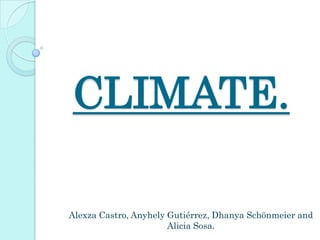
Climate Types and Factors in the Canary Islands
- 1. CLIMATE. Alexza Castro, Anyhely Gutiérrez, Dhanya Schönmeier and Alicia Sosa.
- 2. High mountain climate. The high mountain climate is generally cold and wet weather. Temperatures are low in winter and mild in summer. Rainfall is abundant all year and frequently falls as snow in the winter season. Talking about fauna: Some animals are used to this weather like ,for example the “sarrio”, but other animals suffer or experience changes in their organisms from the cold Respect to flora: Cultivated lands not usually exceed 1,000 meters. Above the forest grows, and from the 1,800 meters, the bushes. Zones: this type of weather is not abundant but is spread around the earth globe.
- 4. Mediterranean climate. A Mediterranean climate is the climate typical of the Mediterranean Basin, and is a particular variety of subtropical climate. The lands around the Mediterranean Sea form the largest area where this climate type is found, but it also prevails in much of California, in parts of Western and South Australia, in southwestern South Africa, sections of Central Asia, and in central Chile.
- 5. Precipitation: A Mediterranean climate is the climate typical of the Mediterranean Basin, and is a particular variety of subtropical climate. The lands around the Mediterranean Sea form the largest area where this climate type is found, but it also prevails in much of California, in parts of Western and South Australia, in southwestern South Africa, sections of Central Asia, and in central Chile Temperature: The majority of the regions with Mediterranean climates have relatively mild winters and very warm summers. However winter and summer temperatures can vary greatly between different regions with a Mediterranean climate.
- 6. Hot-summer Mediterranean climate. This subtype of the Mediterranean climate is the most common form of the Mediterranean climate, therefore it is also known as a “typical Mediterranean climate”. Regions with this form of the Mediterranean climate typically experience hot, sometimes very hot and dry summers and mild, wet winters. In a number of instances, summers here can closely resemble summers seen in arid and semiarid climates. However, high temperatures during summers are generally not quite as high as those in arid or semiarid climates due to the presence of a large body of water. All areas with this subtype have wet winters. On the other hand, some areas with a hot Mediterranean subtype can actually experience very chilly winters, with occasional snowfall. Precipitation is heavier during the colder months. However, there are a number of clear, sunny days during the wetter months.
- 8. Climate factors of Canary. The cold Canary Current: the archipelago is under the influence a cold ocean current called cold Canary Current, which transports waters from higher latitudes. This results in that the temperature of the sea surface is maintained at significantly lower with Canary respect to the latitude in which it is located. In summer this is further accentuated, so that the water temperature of the sea around the Canary Islands is almost equal to that of the Azores, located farther north
- 9. The insular relief: how relief of the Canary Islands is quite different from one island to another, and even within the same island can find areas with great topographical variety. Well defined mountain leave the northern slopes, influenced by the trade winds, the south slopes, sheltered of these (La Palma, Tenerife and Gran Canaria). On islands where there is no height enough to trap moisture that bring the trade, they spend long without downloading it. This is the main cause of the aridity of islands such as Lanzarote and Fuerteventura.
- 10. Trade winds: are a regular and moderate, warm, dry winds origin but the load across the ocean moisture and cool. these winds originate in an area close to the Azores area. In summer it is when Canary islands are under the full influence of these winds. in winter the influence is less because the rules of the trade winds can be altered other climate disruption. The trade winds have two components: a superficial, lower trade winds, which blow from the northeast between 900 and 1 500 meters, and is presented as a cool, wet wind. above the first trade wind blows top, which has a northwesterly direction, it is a wind dry and relatively warm.